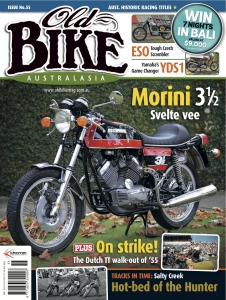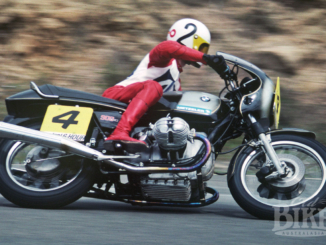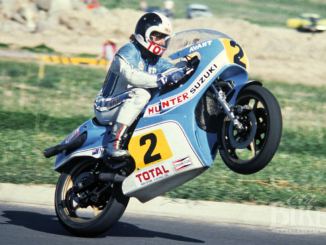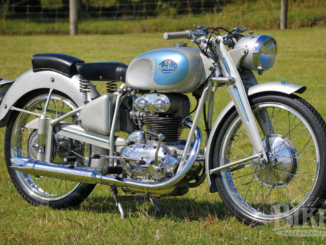
Story and photos: Jim Scaysbrook
Three and a half – that’s the unlikely appellation for what has become a classic of ‘seventies Italian design flair.
In racing circles, the name Moto Morini will forever be associated with the giant killing DOHC 250cc single that so nearly humbled the mighty Honda squad in the 1963 World Championship. That fabulous machine, undoubtedly the fastest single of its size ever built, was ridden with incredible verve and aplomb by the equally legendary Tarquino Provini, and at the end of the ten round contest, just a single slip of paper stood between the tiny Bologna factory and the crown. That slip of paper was the visa denied Provini to contest the East German Grand Prix in August, for he ended up second in the World Championship to the works Honda of Jim Redman by just two points, and won four races – the same as Redman. Morini also chose not to contest the Isle of Man TT, a decision that may also have cost them the title.

Morini’s history as a motorcycle manufacturer actually dates back much further – to 1924 when Alfonso Morini joined forces with fellow engineer and enthusiast Mario Mezzani to produce a 123cc 2-speed two-stroke which was marketed as an MM. With Morini himself in the saddle, the little MM scored considerable success in the open road races that were popular in the day, and seen as vital for sales. MM produced their first four stroke racer – a 175cc with a chain-driven single overhead camshaft – in 1932, and this was soon followed by a 250 and a 350.
During the war, the Morini factory was flattened, and it was late 1945 before it was rebuilt. When motorcycle production resumed, it was under the Moto Morini name, not MM, and a small range of utility motorcycles using a DKW-inspired 125cc two-stroke engine were the first products. They sold well – well enough for Alfonso to invest in an all-new 125 four stroke that appeared in 1948. Capable of spinning to 10,000 rpm, at which point it produced 12 hp, the 125 was an instant hit with the legions of sporting types in Italy, and was soon joined by a lower spec 250. Then came the 175 Settebello which not only found immediate favour as a sporting motorcycle, but was produced in large numbers for the military and in enduro form. The 175 and the later 250 formed the basis for racing machines that launched the careers of some of Italy’s greatest riders, not least of which was a young Giacomo Agostini, with his Mike Hailwood replica white and gold helmet.
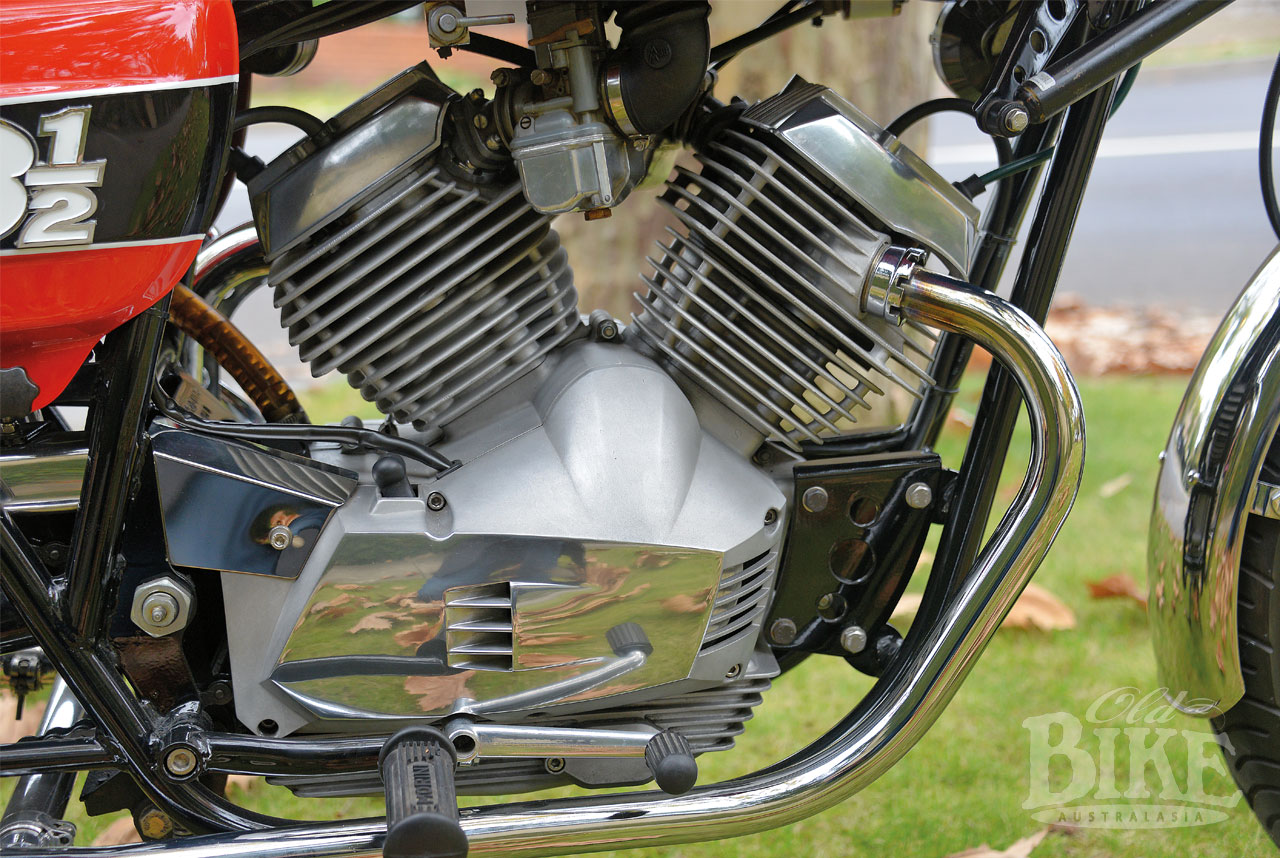
During the 1960s, the overhead camshaft road bikes which formed the mainstay of the consumer range became increasingly expensive to produce in a very price-conscious market, and Morini’s engineers designed a new range of pushrod four strokes, beginning with a 148cc model. The OHV range soon expanded to include 49cc, 98cc, and 124cc. When Alfonso Morini passed away in 1969, his daughter Gabrielli assumed control of the business, and plans had already been laid for a completely new range of motorcycles that would take the company into the ‘seventies and beyond.
The vee story
The post-Alfonso Morini company comprised chief designer and general manager Gianni Marchetti, and former Ferrari designer Franco Lambertini Jnr, who was responsible for the new range of overhead valve 72º vee-twins, which began with the 350cc 3 ½ model. The engines were built by the Marchesini brothers, Gino and Franco. While the design may these days seem fairly straightforward, it was ground-breaking stuff in 1970. Certainly, there had been Italian v-twins before like the famous Moto Guzzi racers, but the new Morini was very carefully thought out to be a practical proposition for mass production. To this end, the engine featured ball and plain bearings in the bottom end and gearbox, making it relatively inexpensive and simple to produce. However it broke new ground in abandoning the hemispherical combustion chamber – with its inherently wide valve angles – in favour of vertically positioned valves with a flat roof combustion chamber and flat-topped pistons with a kidney-shaped concave recess – the so called “Heron” design that had been pioneered by the British Cosworth company for the Ford-badged Formula One engine. This method was both cost-effective, fuel efficient and performed very well. The rear cylinder was offset by 5cm, which allowed the two connecting rods to be placed side by side on a common crank pin. It also provided a better stream of cooling air for the rear cylinder – always a problem with v-twins set longitudinally in the frame. The crankshaft itself was a one-piece forged affair running slipper big end bearings and ball main bearings.
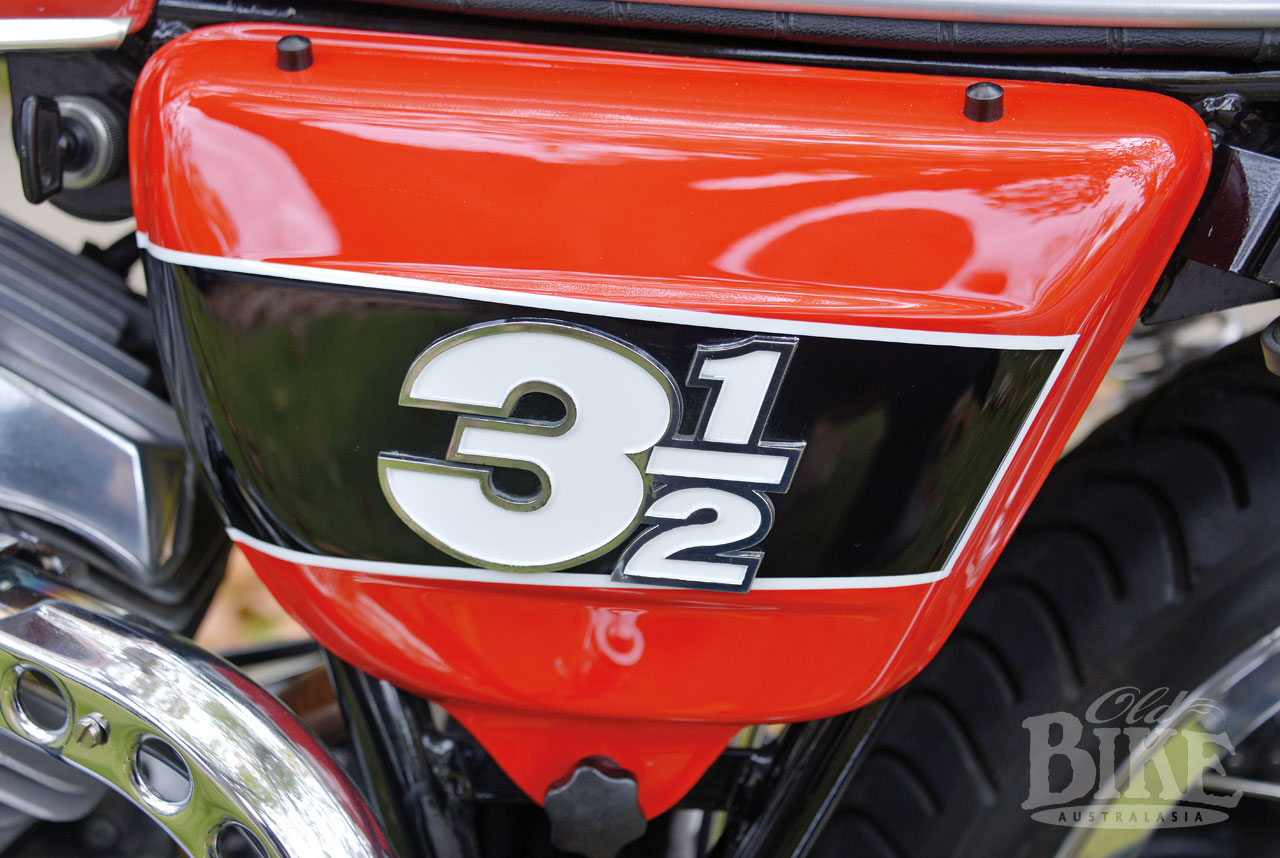
A toothed belt drove the camshaft which was located as far up the crankcase as possible to minimise pushrod length, with a slatted vent on the right side crankcase cover to allow air (and probably other contaminant like water and dirt) to cool the belt and thus extend its life. The clutch, on the left side, was similarly vented. Gear primary drive and a dry clutch coupled the six-speed gearbox. Mixture was fed by a pair of 25mm Dell’Orto carburettors breathing through a single air filter located under the fuel tank, with sparks provided by a Ducati electronic ignition system. The cylinder heads and barrels were identical and interchangeable, further minimising production costs, although this meant the exhaust port on the rear cylinder head faced backwards, out of line with the direct air flow. 125cc and 250cc single cylinder engines, using the same basic design as the 350, were also drawn up, with an enlarged v-twin of 500cc not far down the track.
The new 350 went on sale in Italy in 1973 and was catalogued in two models, the Strada (street/touring) and Sports, the former listed with 36hp and the latter putting out 39hp at 8,200 rpm and being quoted as having a top speed of 100 mph (161 km/h). The Sport actually did not appear until late 1974, and then only in limited numbers for the home market. It was late 1975 before the Morini Strada went on sale in Australia, with the Sport model joining it in 1976. The Strada was available in two colour schemes; red/black or blue/white.
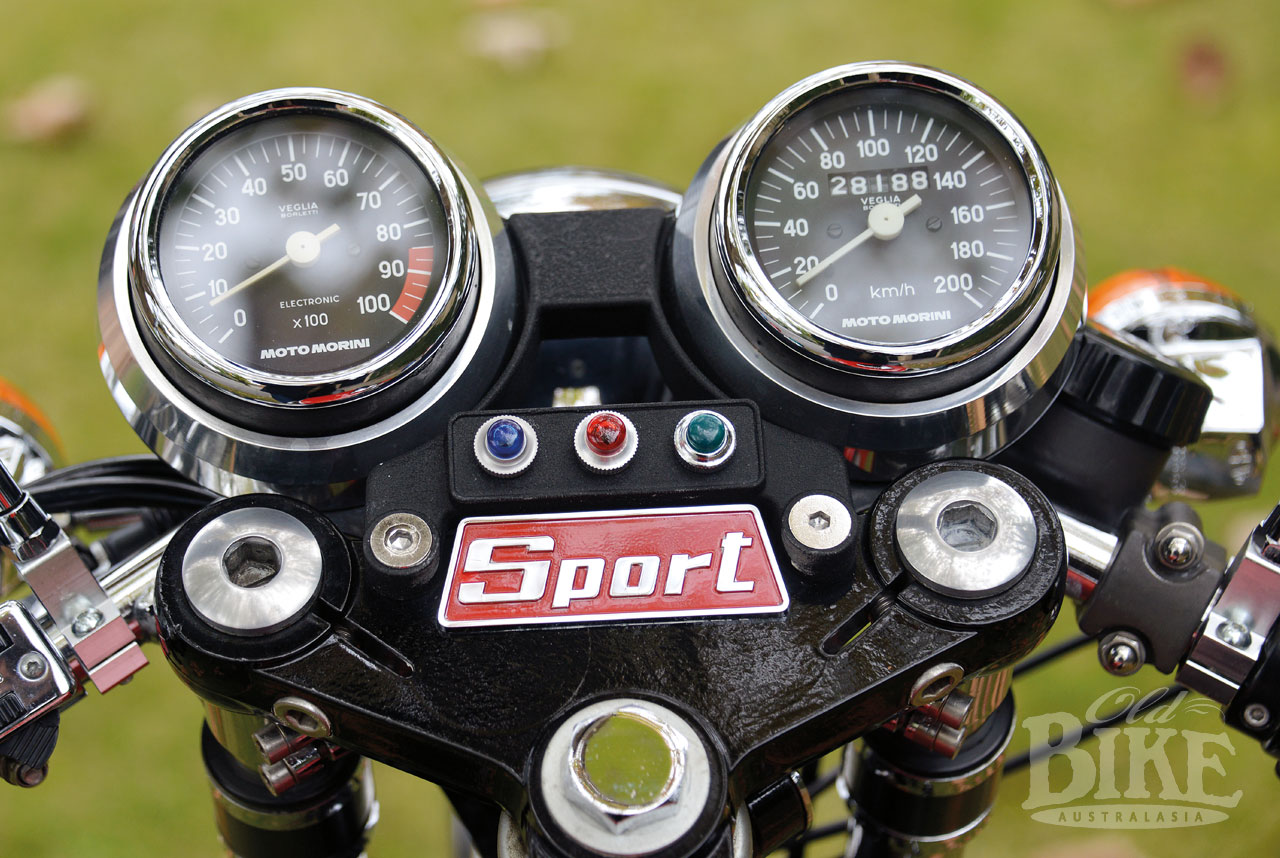
The slap of reality
Despite the stringent requirements for economic efficiency in production, the 3 ½ was far from cheap, selling for nearly as much as the new Honda CB750 in most markets – around $1,500 in Australia. There was no denying that it was a sensational looking machine and handled beautifully, but was still a 350. Instead of the disc brakes that were becoming de rigueur on the Japanese and British motorcycles, the Morini stuck with drums – a large diameter 230mm Grimeca twin leading shoe at the front and a smaller single leading shoe version at the rear. Marzocchi suspension and the fairly standard CEV switchgear found on many Italian machines of the time was used. Initially, only kick starting was employed, but later models had electric starters fitted. Curiously, the petrol tap was operated by an electric solenoid (with a manual tap on the right side for reserve) which indicates its existence with an audible ‘click’ when the ignition is turned on. The ignition switch itself is all but hidden at the left side rear of the fuel tank.
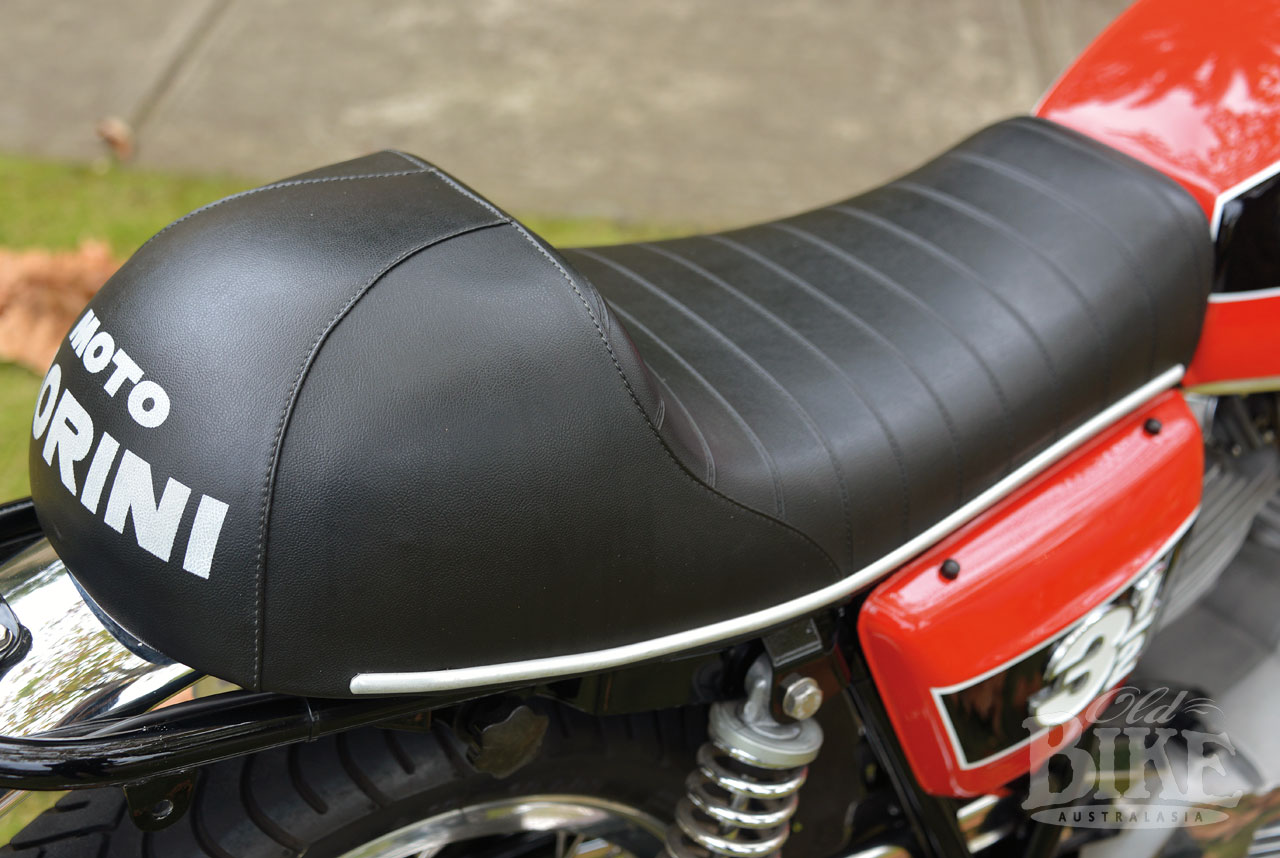
The Strada and Sport differed in more than just internal specification. Steel rims were used on the Strada and Borrani alloy rims on the Sport, which also had a hump-back racing style seat, lower handlebars (which involved moving the instruments slightly further forward) and a hydraulic steering damper. The Sport’s compression ratio was also raised from 10.0:1 to 11.0:1.
The drum front brake soon gave way to a single 260mm Grimeca disc, and later still a twin disc set up was offered as an option. The rear wheel could be removed without disturbing the chain.
The twins, in both 350cc and 500cc (introduced in 1977) form soldiered on with detail refinements, but by the mid-1980s Moto Morini was on its knees, and was sold in early 1987 to Cagiva, owned by the Castiglioni brothers who, at the time, also owned Ducati. A new version of the 350, called the Dart, was released in 1988, along with a US-styled version called the New York, but otherwise Cagiva showed little interest in Morini and the brand declined into obscurity. In 1996 both Ducati and Moto Morini were sold to the US group TPG.
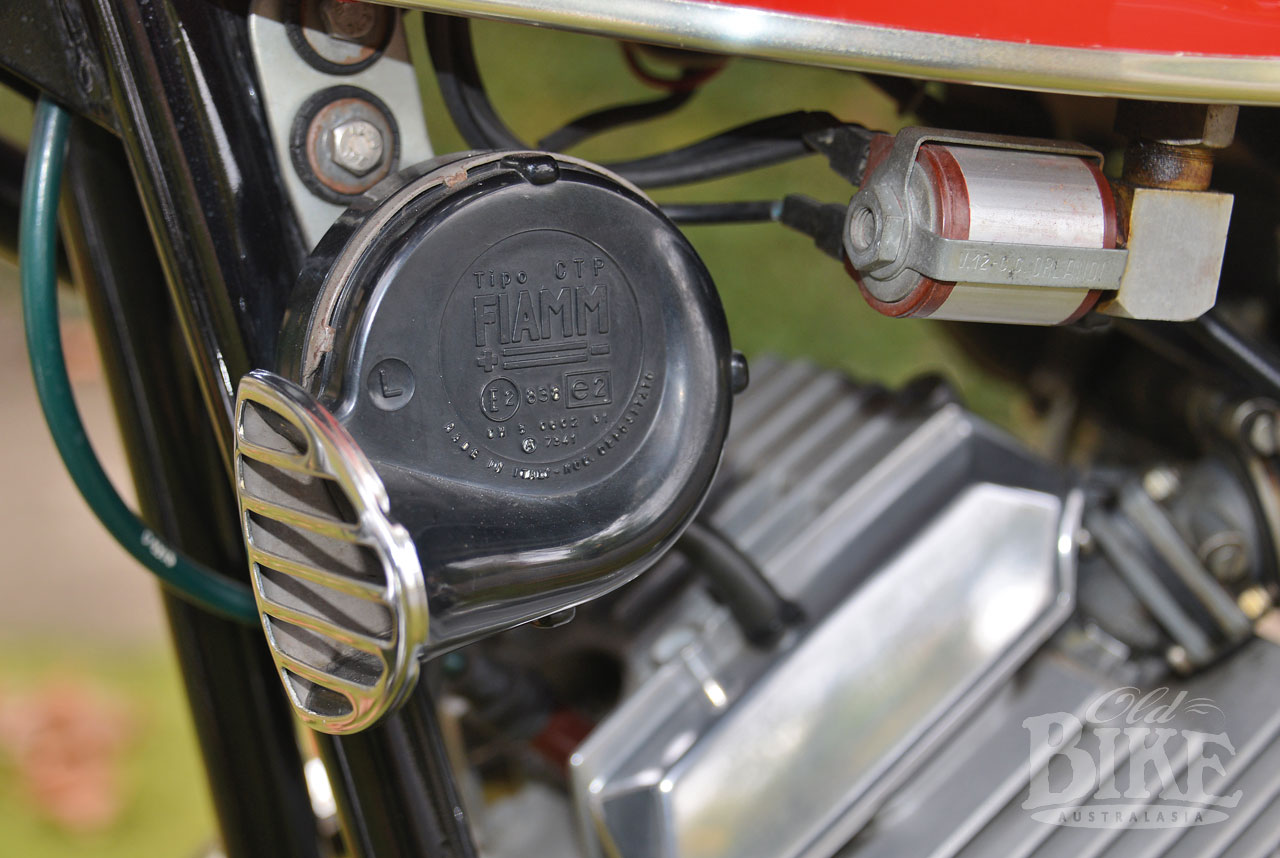
Franco Morini, Alfonso’s nephew, managed to purchase the Moto Morini name in 1999, and in 2004 a 1200cc model named the Corsaro was announced. However the venture lasted only five years until the company went into voluntary liquidation. After another sale, limited production began in 2012, with several variants of the 1200 being shown from time to time at European motorcycle shows.
When the Moto Morini factory closed, the existing parts and equipment were bought up by Cesare Luzzi, who offered a comprehensive spares service for many years. When Cesare died, the business was taken over by his son Alessandro and now operates from Sienna as Luzzi Moto Morini.
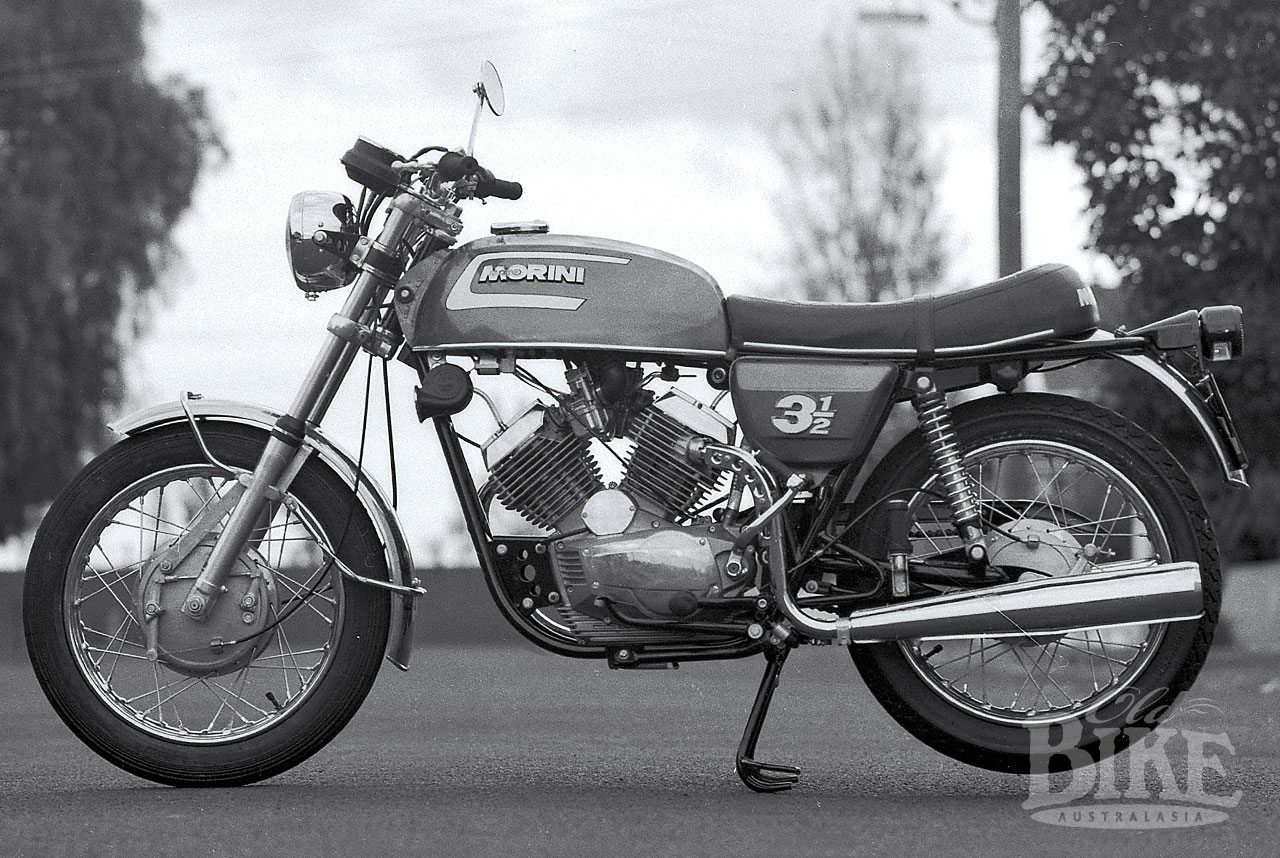
An Aussie Sport
The Morini 3 ½ is probably more popular today than at any point in its history. A legion of fans and members of the numerous Morini clubs worldwide revere the brand and provide a healthy market for the spares scheme. Surprisingly, given the limited number of the v-twins sold in USA, a seemingly large repository of spare parts exists there.
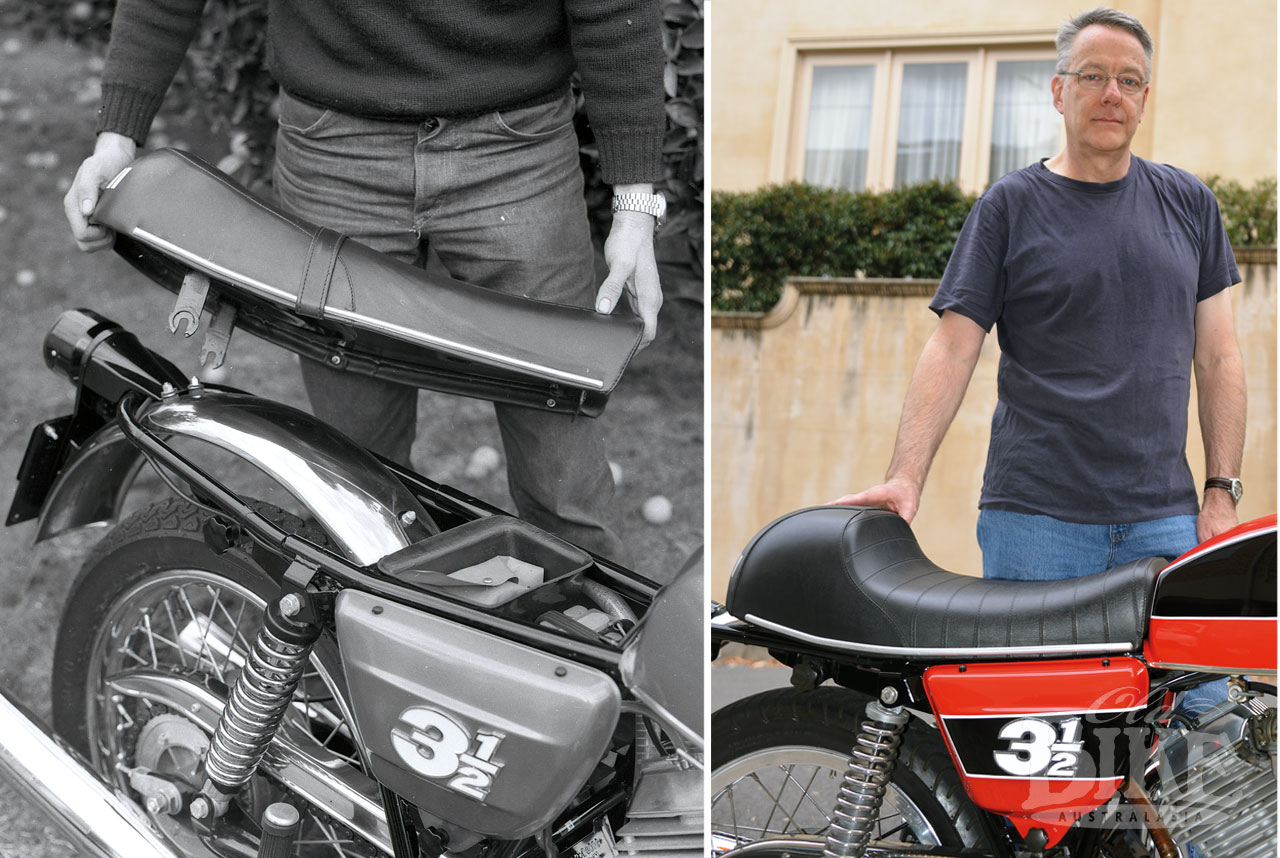
Melbourne-based Ian Barnes is the owner of the 1975 3 ½ Sport featured here, and until recently owned a 500 as well which has since been sold to a Sydney collector. His Sport has the single Grimeca disc front end and was sourced from UK Italian bike specialists North Leicester Motorcycles in 1996. At the time, it had 13,000 kilometres on the clock, and Ian has added a further 15,000. “It’s a regular ride to Phillip Island and to the Italian Day in Melbourne,” says Ian. “I am in the Classic Italian Club (CIMAA) and we get out fairly regularly for rides. The Morini performs pretty well for a 350, but you have to ride it like a two-stroke as the power is only there between 6,000 and 8,500 rpm. That said, it will cruise all day at 5,000. I had a 1980 model 500 and there’s not that much difference (to the 350) except for more mid-range torque. It’s very reliable and easy on parts, although the swinging arm bushes wear so you have to keep them well lubricated, and the carbs tend to wear as well.”
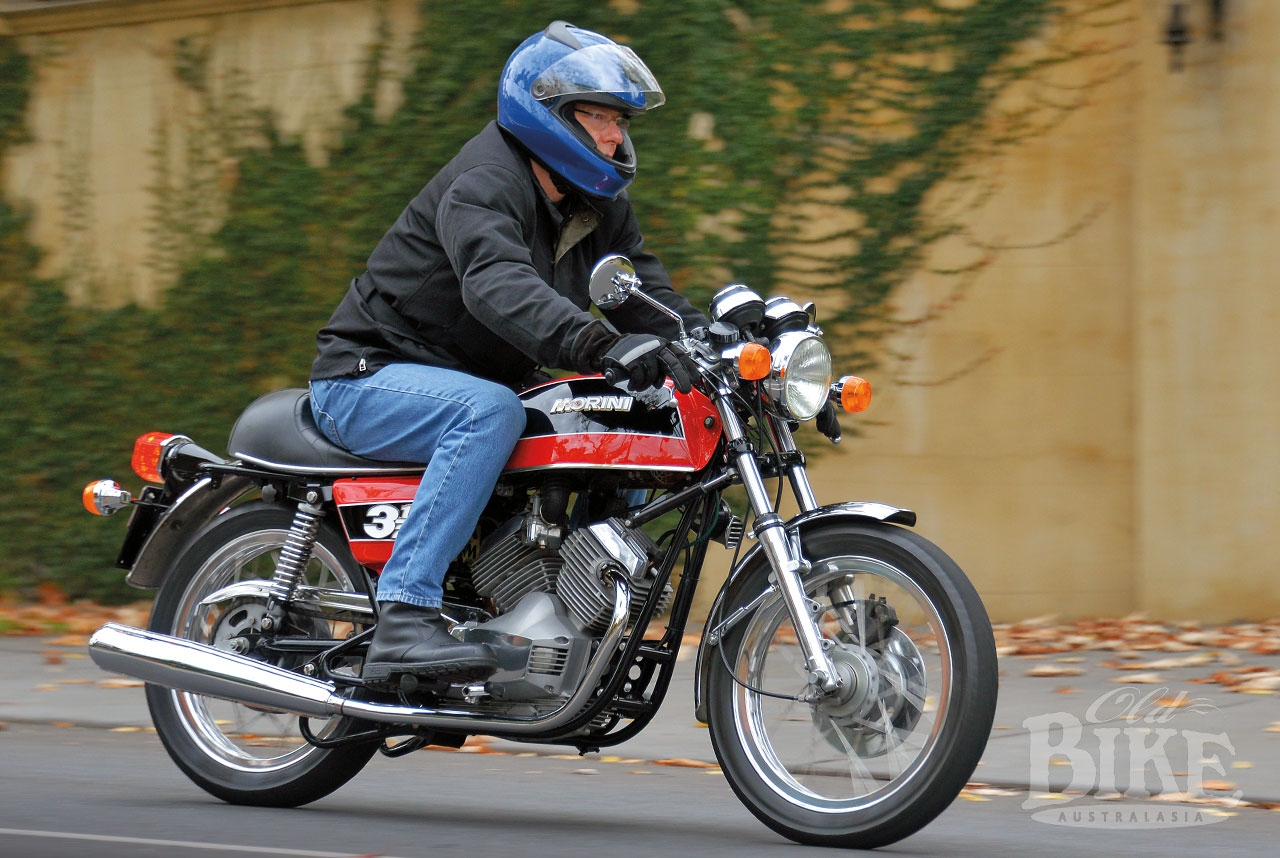
There’s no disputing that the Morini is a stunning looking motorcycle, distinctively Italian in the style of the ‘seventies. It sounds good too, that little v-twin rasping away in the crisp morning autumn air on the day I photographed it in Melbourne. Ian says the electric starter is a bit delicate, and preferred to use the kick starter, which did not appear to be too difficult. And while the handling would not be tested around Toorak’s leafy streets, I have no reason to doubt him when he says that on ‘proper motorcycling roads’ it is an absolute delight.
It’s a shame that the most recent travails of the once-illustrious Moto Morini brand have been rather tragic, but for lovers of classic Italian motorcycles, the Moto Morini 3 ½ rightly holds a special place.
Specifications: 1975 Moto Morini 3½ Sport
Engine: 72º v-twin, 2 valves per cylinder, pushrod.
Bore x stroke: 62mm x 57mm
Capacity: 344cc
Power: 39hp @ 8,500 rpm
Lubrication: wet sump 2.5 litres capacity
Ignition: Ducati Electronic.
Carburetion: 2 x 25mm Dell’Orto VBH BS concentric type.
Electrics: 12 volt 100W alternator.
Primary drive: Helical gear to dry clutch.
Gearbox: Six speed
Starting: Kick or electric.
Fuel capacity: 14 litres
Frame: Tubular steel full cradle.
Wheels/tyres: Front: 3.25 x 18
Rear: 4.10 x 18
Brakes: Front: 260mm Grimeca disc.
Rear: 230mm Ceriani sls drum cable operated.
Forks: Marzocchi telescopic.
Rear suspension: Twin Ceriani units with five-way preload adjustment.
Dry weight: 144kg
Price in Australia (1976): $1,585.00 (Strada) $1745.00 (Sport)
